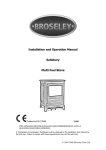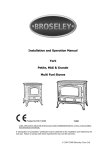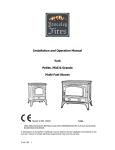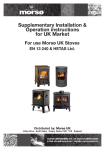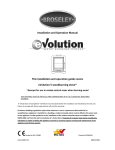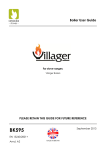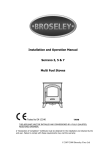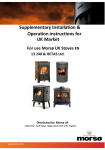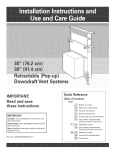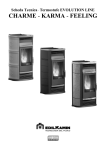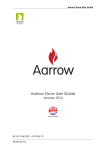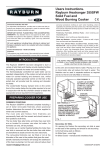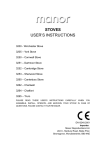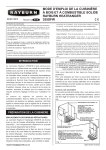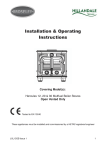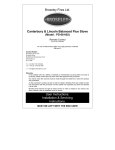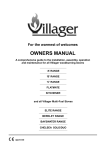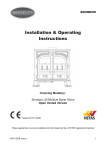Download Broseley 20B Specifications
Transcript
I Installa ation an nd Ope eration Manual Hercules 12, 20, 30 Boiler Models M s Multti Fuel Stove S Tested to EN 13240 THIS APP PLIANCE MUST BE IN NSTALLED AND A COMM MISSIONED D BY A FUL LLY QUALIFIED ENGINEER. DIY INSTALLAT I TIONS ARE E NOT REC COGNISED IN TH HE GUARA ANTEE RE EAD AND D FOLLO OW THE INSTALLATION AND OP PERATIN NG INSTRU UCTION NS FULLY Y. Failure e to com mply with these require ements may m void d the wa arranty. Herrcules Boileer Model 1 HERCULES MULTIFUEL SAFETY BOILER STOVE INSTALLATION AND OPERATION MANUAL Thank You May we take this opportunity to thank you for choosing a Hercules, cast iron Multi-fuel Boiler stove. Please take time to read this manual and follow the guidelines on how to install and operate your new stove, as we feel sure it will enable you to use it to its best advantage for many years. The term multi-fuel refers to the fact that the appliance is capable of burning both wood and coal. Both of these fuels have very different requirements if they are to burn correctly. The air controls on the appliance allow the chosen fuel to burn efficiently. On an open fire, the necessary conditions to allow both wood and coal to burn is done so at the expense of efficiency, sending more than 80% of the heat produced straight up into the chimney. The efficiency figures for our M/F stoves are much higher as there is far greater control over the combustion air entering and leaving the appliance. SEE THE SECTIONS ON PAGE 15 - “Burning Wood” and “Burning Coal” FOR A FULL LIST OF RECOMMENDED FUELS. After reading this document, if there is anything you are unsure about, please contact your dealer or our Technical Support Department on 01743 461444. Useful organizations Solid Fuel Association 0845 601 4406 www.solidfuel.co.uk The National Association of Chimney Sweeps 01785 811732 www.chimneyworks.co.uk HETAS Ltd. 0845 634 5626 www.hetas.co.uk Health and safety precautions Special care must be taken when installing the stove such that the requirements of the Health and Safety at Work Act are met. Handling Adequate facilities must be available for loading, unloading and site handling. Fire Cement Some types of fire cement are caustic and should not be allowed to come into contact with the skin. In case of contact, wash immediately with plenty of water. Asbestos This stove contains no asbestos. If there is a possibility of disturbing any asbestos in the course of installation then please seek specialist guidance and use appropriate protective equipment. Metal Parts When installing or servicing this stove care should be taken to avoid the possibility of personal injury. Hercules Boiler Model 2 INSTALLATION OF STOVE These instructions cover the basic principles to ensure the satisfactory installation of the stove, although detail may need slight modification to suit particular local site conditions. In all cases the installation must comply with current Building Regulations, Local Authority Byelaws and other specifications or regulations as they affect the installation of the stove. It should be noted that the Building Regulations requirements may be met by adopting the relevant recommendations given in British Standards BS 8303, BS 6461 and BS 7566 as an alternative means to achieve an equivalent level of performance to that obtained following the guidance given in Approved Document J. We recommend that you seek the services of an installer who is conversant with stove installations and Building Regulations. It is most likely that the shop where you purchased the stove will be able to help in this respect. It is our general policy to supply specialist Fireplace shops. These shops can offer an after sales service and will be able to offer advice when necessary. Please note that it is a legal requirement to comply with Building Regulations and that the installation of the stove is certified by Local Authority Building Control. It is the responsibility of the appliance owner to notify Building control for certification. It is also a requirement under the guarantee that all installations and operation complies to the instructions to follow. No installation should be undertaken unless the installer is suitably qualified. Stove Performance The Hercules stove range has been CE approved as an intermittent operating appliance for burning manufactured or naturally occurring smokeless fuels and wood logs only. It should be noted that it is an offence to burn wood logs in this stove if it is installed within a Smoke Control Area in the UK. 12B 20B 30B Maximum heat output to room (kW) 4 6 8 Maximum heat output to water (kW) 8 14 22 Flue diameter MINIMUM* 7 inch *please note a larger flue diameter may be required if the flue design demands it. Efficiency % 73 75.4 Temperature exhaust gas – wood (ºC) 190 Optimal working temperature 70º - 75º 75.4 Boiler capacity (litres) 18 20 22 Flow & return pipe fitting (female) 1 ½ BSP 1 ½ BSP 1 ½ BSP Flue draft Pressure (tested when hot) WOOD (mbar/Pa) 0.17 – 2 17 – 2.0 0.17 – 2 17 – 2.0 0.17 – 2 17 – 2.0 Maximum working temperature 94º - 95º Stove depth (mm) 440 510 620 Stove Height (mm) 768 768 768 Stove Width (mm) 747 747 747 Stove Weight (Kg) 201 225 252 Hercules Boiler Model 3 Additional Air A permanent air entry opening or openings with a total free area of at least 550mm2 per Kw of appliance rated output above 5Kw. If a flue draught stabiliser is used, extra ventilation will be required. There must not be an extractor fan fitted in the same room as the stove as this can cause the stove to emit fumes into the room. Hearth And Clearances Your stove must be installed on a solid, level non-combustible hearth and with a gap of at least 600mm from any combustible material such as beams or skirting. The hearth protrusion in front of the stove to carpets or wooden floors must be at least 300mm. As it is possible, that on opening the door of the stove for fuel to fall out, a fender must be fitted if the hearth is flush with the carpet. These are just a few hearth specifications. Please refer to Building Regulations Approved Document J (Hearths) for more specific details. Stove Clearances Non-Combustible Combustible A 100mm 200mm B C Above 100mm 400mm 300mm 300mm 200mm 600mm Minimum hearth thickness 12mm Constructional hearth required of 125mm minimum The appliance should be sited in a properly constructed brick fireplace or recess allowing a gap of 100mm all round, at the rear and both sides. The fireplace walls must be made of solid non combustible material and at least 75mm thick. The hearth should be level and the appliance fitted at right angles to it. Fireplace walls need to be at least 1.2m above the hearth and at least 300mm above the appliance. The hearth has to be able to support the weight of the appliance and any flue bearing down upon it. The clearance distances to combustible material beneath, surrounding or upon the hearth and walls adjacent to the hearth should comply with the guidance on the separation of combustible material given in Building Regulations Approved Document J and also in these stove instructions. Hercules Boiler Model 4 Chimney This appliance must not be fitted into a chimney serving another heating appliance. It is most important that there is no obstruction in the flue or chimney. Please ensure that any existing chimney is clear of obstruction and swept clean immediately before installation of the stove. If the chimney has been used for an open fire it is recommended that it be swept for a second time having been used for a month following installation. As a closed appliance operates at a higher flue temperature, it is possible for deposits that were previously adhered, to be dislodged, with the consequent risk of flue blockage. Flue Draught Performance of a flue is dependent on its materials, size and configuration, and the position of its outlet. In the final design of all these parameters must be considered to insure that the appliance performs to its full potential. When commissioning, a flue draught measurement must be taken, if excessive corrective measures must be implemented. The flue draught is taken when the appliance is running at its working temperature. Please see data table for correct figures. An excessive flue draught will potentially damage the appliance, flue and/or the property and void any warranty. The outlet from the chimney should be above the roof of the building in accordance with the provisions of Building Regulations Approved Document J. If installation is into an existing chimney then it must be sound and have no cracks or other faults which might allow fumes into the house. Older properties, especially, may have chimney faults or the cross section may be too large i.e. more than 230 mm x 230 mm. Remedial action should be taken, if required, seeking expert advice, if necessary. If it is found necessary to line the chimney then a flue liner suitable for solid fuel must be used in accordance with Building Regulations Approved Document J. If there is no existing chimney then either a prefabricated block chimney in accordance with Building Regulations Approved Document J or a twin walled insulated stainless steel flue to BS 4543 can be used. These chimneys must be fitted in accordance with the manufacturer’s instructions and Building Regulations. The liner diameter must not be less than 7”. If the draw on the chimney is excessive, a flue draught stabiliser will help to slow this down. An excessive draw may cause over firing and thus cause the internal components of the stove to wear out quicker.. Any bend in the chimney or connecting fluepipe should not exceed 45°. 90° bends should not be used. Adequate provision e.g. easily accessible soot door or doors must be provided for sweeping the chimney and connecting fluepipe. Hercules Boiler Model 5 S SUMMARY Y OF FLUE PROBLEMS Figu ure 1 – Sum mmary of flu ue problemss The e chimney should be e insulated d and be a minimum of 4.5m h high to ach hieve suffic cient draw w. If there are any be ends in the flue a higher chim mney may y be required. In alll cases loca cal building g regulatio ons must b be satisfied ed. If flued from the top off the stove e the flue pipe p must rise vertic cally a min nimum of 600mm 6 be efore any bends b to ensure e ade equate dra aw. Horrizontal se ections of flue f should d be avoid ded as thes se reduce draw and can bec come block ked with deposits. d A va ariety of chimney c co owls are av vailable to o reduce downdrafts d s in the chim mney. If you y are exp periencing g downdra afts you sh hould consult a chim mney spe ecialist to find f the be est solutio on for yourr chimney.. Herrcules Boileer Model 6 Figure 1b Hercules Boiler Model 7 Connection to Chimney Flue A single wall metal fluepipe is suitable for connecting the stove to the chimney but is not suitable for using for the complete chimney. It is important that the connection between the stove spigot and the flue pipe is effectively sealed with heat resistant fire cement and/ or glass fibre rope to prevent harmful gases leaking into the room. The diameter of the flue spigot (pre fibre roped) provided with the stove is 8” (200mm) and can only be fitted to the top of the stove and must be tightly fitted to the opening. Air must not be drawn in at this point as it will affect the stoves performance. The stove may be fitted with a 7” (175 mm) flue (In most situations 175mm diameter flue pipe will not be suitable for chimneys less than 7.5m high, and must be used in conjunction the ‘reducer ring’ supplied with the stove as a standard part). To get the best transfer of heat from the stove into the room there are two factors to consider when installing into a fireplace recess. Firstly, the flue pipe from the stove must pass through a top ‘register plate’. A top register plate is the term used for a flat plate which is installed inside the chimney (usually out of sight) to prevent heat in the room being drawn up the chimney to waste when using the top or rear flue outlet. This register plate must be made of a non-combustible material such as steel, asbestolux, or masterboard. It is advisable to seal this register plate to the walls of the chimney and also around the flue pipe. Provision of a trap door in this closure plate, or a soot door in the flue for access to clean the chimney from time to time, is recommended. Secondly, the more forward the stove can be sited on the hearth, the more heat will be radiated into the room. But remember the 600mm clearance distance from combustible materials and the 300mm distance to the front of the hearth. Combustion Air Supply In order for the stove to perform efficiently and safely there should be an adequate air supply into the room in which the stove is installed to provide combustion air. This is particularly necessary in modern houses where drafts have been almost eliminated by double glazing etc. There must not be an extractor fan fitted in the same room as the stove as this can cause the stove to emit fumes into the room. It is necessary to install a wall vent to provide the necessary combustion air and to prevent the depletion of oxygen in the room. Plumbing the Appliance The plumbing must be in accordance with all the relevant regulations and practices. The central heating should be pump driven as with other types of boilers. 28mm diameter flow and return piping must be used for the initial run to the tank or heat store. The shorter the run of pipe work the more effective the water heating will be, the cylinder and pipe work should be lagged to minimise heat loss. Hercules Boiler Model 8 Boiler Connections All boiler models are fitted with 4 connections for piping. These connections are 1 ½ Inch BSP and are a female thread. It is possible to only use 2 of these connections, however opposite angles must be used – For example Flow top right, return bottom left. The 2 excess connections can then be capped off. Checks on Initial Firing Before connecting up the boiler the installer must ensure that they thoroughly flush all of the systems pipes in order to remove any residue which could compromise the correct operation of all system components (Pumps, valves etc). It is also important to verify the chimney has sufficient draught, there are no blockages and that no other appliance exhausts are inserted into the flue. Filling up the System Once all connections are complete the installer can proceed with the boiler connection. Open all the vent pipes of the radiators, the boiler and the system. Gradually open the load valve, ensuring that the air vent pipes are working correctly. Assembly of Stove For top outlet flue assembly Place the Top Plate casting on the hearth and use a plumb line to determine the centre point for the flue alignment from the opening in the closure plate to the flue outlet opening of the Top Plate. Mark the position of the four corners of the Top Plate with a piece of chalk (these correspond exactly with the four corners of the Base Plate casting). Place the Base Plate over the chalk marks Use the chalk marks as the ‘template’ to accurately position the Base Plate (the use of the four Base Cups is optional but when used ensure these are squarely seated and accurately located under the Base Plate). Check the Base Plate with a spirit level and if necessary adjust the height by turning the cups. From this stage onwards the final position of the stove assembly is set. Fit the Boiler Unit Place the Boiler Unit onto the Base Plate and ensure that the bottom edges are properly located onto the rebated Rope Seal that runs around the four sides of the Base Plate. It may also be advantageous to fit the plumbing elbows and the first lengths of pipe to the Boiler Unit before locating on the Base Plate close to the rear wall of the fireplace opening within which the stove is to be located. Ensure that the ‘flow’ and ‘return’ pipes to the primary and secondary circuits respectively, are fitted ‘diagonally-opposed’ for efficient water circulation within the Boiler Unit. Hercules Boiler Model 9 Fit the Front Plate Offer the vertically recessed rope seals to the leading edges of the Boiler Unit (the top edge of the Top Plate should be about 50mm above the top edge of the Boiler Unit) and allow the Front Plate to slide down until the catches engage with the pins located on the Boiler Unit. To ensure that the Front Plate has been securely located place a woodblock on the top edge of the Front Plate and apply a sharp tap with a lump hammer to the woodblock. WARNING !!! DO NOT HIT THE CASTING DIRECTLY - IF THE FRONT PLATE IS STILL NOT SECURE CHECK THE LOCATION AND SEATING OF THE FRONT PLATE AND LOCATION OF THE CATCHES AND PINS - THIS IS A SIMPLE AND STRAIGHT FORWARD OPERATION AND EXCESSIVE FORCE MUST NOT BE USED. The Front Plate will be easier to handle if the Doors are taken off by removing the Fixing Pins which can be tapped out from underneath the Hinge Blocks. Fit the Baffle Plate Place the Baffle Plate on the supporting brackets. The bracket on the baffle faces the base of the stove. Fit the Fire Grates Place the two half Fire Grates on the supporting ledges (ribbed face underside). Fit the Fuel Retainer Bars Place the first Fret Rail with the flat ash deflector bar between the back face of the Front Plate and the steel Retaining Plates. Place the second and third Fret Rails on top of the first Fret Rail The notched ends of the Fret Rails face inwards and are loose fitting. Fit the two Ash Pans Place the Ash Pans side-by-side in the ash-pan compartment below the Grates. Fit the Top Plate Place the Top Plate onto the stove body and check that it is centrally located and seated onto the wide recessed rope seal. The Top Plate relies upon self-weight to seal (do not use fire cement to seal). Hercules Boiler Model 10 Commission/Handover Ensure loose parts are fitted in accordance with the instructions for “Assembly” given above. On completion of the installation allow a suitable period of time for any fire cement and mortar to dry out, when a small fire may be lit and checked to ensure the smoke and fumes are taken from the stove up the chimney and emitted safely to atmosphere. Do not run at full output for at least 24 hours. On completion of the installation and commissioning ensure that this installation and operation manual for the stove is left with the customer. Ensure to advise the customer on the correct use of the appliance with the fuels likely to be used on the stove and warn them to use only the recommended fuels for the stove. Advise the user what to do should smoke or fumes be emitted from the stove. The customer should be warned to use a fireguard to BS 6539 in the presence of children, aged and/or infirm persons. Advise the user not to fit an extract fan in the same room as the stove as this can cause the stove to emit fumes into the room. Insure the boiler system is fully operational and performs to the design specification. Insure any safety features are fully operational. Also check the following points and insure they have been addressed: 1. Flue draught is correct 2. Flue draught measurement = 3. Flue soundness 4. Flue operation correct 5. Flue data plate completed 6. Appliance smoke tested 7. Hearth fitted to current standards 8. Correct air brick/ventilation installed 9. Ensure the heating system is functioning correctly Hercules Boiler Model 11 OPERATION OF STOVE READ THESE INSTRUCTIONS CAREFULLY BEFORE USING THE STOVE It is very important not to leave the stove running with the doors open. This allows far too much air into the stove causing the fire to burn excessively hot and will severely damage the stove. MAINTAINANCE REQUIREMENTS The product you have purchased is a working appliance. It is important that routine maintenance is carried out to ensure its longevity. Rope seals on doors and glass should be checked on installation to ensure a good seal. Place a strip of paper in the door and close it. If the paper can be pulled out without tearing it the rope seal should be adjusted or may need to be replaced. This test should be carried out every few months as the rope seal will degrade with use. Replacement glass rope and high temperature rope glue should be available from your local stockist. The doors of the Hercules are mounted on adjustable hinge blocks. If these have become misaligned during transportation or fitting they should be adjusted so that they close securely. Routine clean out of the firebox, removing grates and cleaning is equally important. Controls Layout Secondary Air Control Tertiary Air Control Primary Air Controls Figure 2 – Control Layout Hercules Boiler Model 12 Ash Pan The ash pans can be removed using the double end of the poker which fits under the top lip of the ash pan. Care must be exercised when opening the doors as the handle and this part of the stove will be very hot. Use the glove provided. Do not put hot ashes into anything other than a metal container unless you know the ashes are cold. Ash pan removal is best done when either the contents of the ash pan have cooled or the stove is out, as some red hot coals can be covered by the ash and may be unseen. Take care not to drop any of the contents of the ash pan on carpet or soft furnishings. Only a slight contact of hot ash may burn a hole. If you remove hot ashes from the stove, use some protection for the floor covering adjacent to the hearth, to account for accidental spillage and always use gloves. Air Controls The stove is fitted with a primary air control and a secondary air control (air wash) which together control the rate at which the fuel is burned. The sections “Air-wash system” and “Starting and maintaining the fire” give more detail of their operation and usage. The Hercules stove also features a tertiary air control found on the right hand side of the stove. Air-wash System This is a system where secondary air is drawn into the stove (by combustion) through the top knob and deflected down the back face of the glass, thus preventing the smoke coming into contact with the glass. It does not mean that you will never have to clean the glass, but substantially lengthens the periods between having to do so. The air-wash system works best when burning dry wood at high temperature. Wet and pitchy wood will produce more deposits on the glass. Also, deposits will form on the back of the glass when the stove is operated on low heat for extended periods. The ‘air wash’ is controlled via the knob situated towards the top of the stove; it is this ‘air-wash’ that keeps a clean and uninterrupted view of the fire, and good secondary combustion of the fuel. This helps to reduce emissions into the chimney and environment. rotating the knob to the left opens the vent allowing more air into the fire so making it burn faster and hotter. Closing the vent slows the combustion rate and in this way you are able to control the rate at which the fire burns. The fire needs some air to burn so closing down all the air supply will make the fire go out. Experience with the fire will show you the right balance of fuel and air to get the best out of your stove. This can be achieved by closing down the secondary air and running the primary air at a minimum, which would usually be set at about one third of the usual running position. In the morning, open the air controls fully to reestablish the fire. Then de-ash and refuel in the normal way adjusting the air controls accordingly. Hercules Boiler Model 13 The tertiary air control The tertiary air control, or afterburner control, is used to burn the smoky fumes and volatile gasses that would normally be lost up the chimney. Because of the lack of oxygen within these gasses, they would not burn any more. When the tertiary air control is used, additional heat will be generated. Using this control helps prevent excessive creosote formation and smoke pollution, it also makes the fire burn at a more efficient rate as extra heat is generated when using this control. Tertiary Air Control Figure 3 – Tertiary Air Control Curing the Stove Before lighting the stove check with the installer that the installation work and commissioning checks described in the installation instructions have been carried out correctly and that the chimney has been swept clean, is sound and free from any obstructions. This curing process may have been undertaken by your installer as part of the stoves’ commissioning and handover and the installer should have shown you how to operate the stove correctly. Your stove is made of a number of cast iron components and we recommended that the first burn should be a small fire for about 30 minutes. This enables the stresses and strains at the joints to be taken up and settle gradually. The second burn can be a larger fire for an hour. During the curing process, the stove will give off a pungent smell and some fumes. This is the paint curing and is quite normal. Provide ventilation whilst this is happening since the fumes can be quite strong and may set off smoke alarms in the room. The paint may become slightly lighter in colour when the stove is cured, particularly in the hottest spots. Fire Grate polish can be used to keep the stove in good condition, or stove spray paint can be used to re-touch the stove. The correct stove spray can be obtained from your stove stockist. Hercules Boiler Model 14 Permanent air vent The stove requires a permanent and adequate air supply in order for it to operate safely and efficiently. In accordance with current Building Regulations the installer should have fitted a permanent air supply vent into the room in which the stove is installed to provide combustion air. This air vent should not under any circumstances be shut off or sealed. Recommended Fuels This appliance has obtained CE approval for burning the following fuels – Manufactured and natural smokeless fuels, and wood logs only. The Hercules range have been CE certified burning Manufactured and natural smokeless fuels, and wood logs not exceeding 35cms in length. Approval does not cover the use of other fuels either alone or mixed with the suitable fuels listed above, nor does it cover instructions for the use of other fuels. Although CE certification covers the use of the smokeless fuels listed, the claimed rated output, has been obtained burning a single representative smokeless fuel, under standard test conditions. However, in the home, a variety of operating conditions can occur and the performance of the appliance may vary to some degree with these conditions and different fuels may need to be burnt at different rates to provide the same heat output. The recommended fuels are Wood logs no longer than 35cms (dry, seasoned for a minimum of one year) and solid mineral fuels (e.g. Natural smokeless fuels) The larger briquettes are recommended as they concentrate less heat in one spot reducing the likelihood of damage to the grate. Please find a recommended and non recommended list below. RECOMMEDED FUELS • Dry Seasoned wood logs no longer than 35cms The Solid Fuel Association also lists the following manufactured smokeless coals as suitable for use in a CLOSED APPLIANCE. • • • • • • • • • • • • • • Ancit, Therma, Briteheat, Briteflame, Coalite Ovals, Ecoal, Homefire, Homefire Ovals, Maxibrite, Newflame, Pureheat, Supacite, Surefire, Taybrite, Hercules Boiler Model 15 Anthracite can also be used however as it has a high calorific value. A controlled burn rate is critical, else considerable damage can be caused to the appliance. NON RECOMMENDED FUELS • Wood off cuts and building materials must not be used as fuel at any time. Off cuts can contain chemicals etc that accelerate the burn rate or produce excessive tar deposits and on some occasions harmful gases. The fuels below are suitable for open fires and therefore are not recommended to burn in a closed appliance. • • • • • • • • • Premium Coal House Coal Premium Doubles Coal and Doubles Blend Triple Heat Lignite Nuggets Rough Slack Peat Briguettes Turf Only authorised smokeless fuels may be used in smoke control areas. Under NO circumstances burn ‘petroleum coke’ or ‘House Coal’ as it will burn out the internal grate and baffle plates in a very short period of time and may damage the stove beyond repair. Only burn dry, seasoned wood. This will give a good heat yield and help to keep the glass clean. A growing tree contains 50-95% water. Burning unseasoned wood turns most of the energy released into water vapour which goes into the flue and little heat is given off to the room. The moisture will combine with other combustion products forming a sticky surface and the risk of obstruction, or worse still a chimney fire, is greater. Wood logs are best stored in a stack, sheltered from the weather, in a well ventilated area and raised off the ground. This allows the air to circulate and prevents mildew. Starting and Maintaining the Fire Do not use gasoline, lighter fluid, Kerosene or other flammable liquids to start or rekindle the fire for obvious safety reasons. Build a fire directly on the grate with crumpled newspaper, kindling wood and/or commercially available “firelighters”. Do not allow single pieces of paper to float up the chimney especially alight. This is a common cause of a chimney fire and can cause structural damage to the property. Ensure all air controls (primary and secondary) are fully open to begin with as shown in the pictures above. When the kindling is burning well, add larger pieces of wood or solid fuel to gradually increase the size of the fire. The stove will work more efficiently with the main door closed as you will be able to control the combustion air and the rate of fuel burning. It is not recommended to operate the stove with the fuel loading door open other than to load fuel. When alight the loading door handle and the ash pan handle will become very hot. Please use the glove provided to avoid touching hot parts. There are IMPORTANT differences in the method of operation for burning solid fuel or wood in your stove. Please read both sections even if only one fuel type is relevant to you. Hercules Boiler Model 16 Burning Solid Fuel Solid fuel needs a flow of air for combustion though the bottom of the grate. Wood does not require this and will readily burn on a bed of ash with a flow of air over the top. Use the single end of the poker provided to push the ash and debris through the grate before refuelling. This will allow the passage of air and prevent the grate from clogging. Make sure there is sufficient hot fuel left to allow the fire to pick up once refuelling has occurred. This will look like a level, shallow bed of hot embers with no spaces. After prolonged use you will have a better idea of the refuelling interval and procedure. Control the rate of burn by opening and closing the primary air. The fuel will burn fastest with the primary air fully open. To get the fire going open the air controls. Once it is established, close the secondary air and use the primary air for controlling the rate of burn. Once the fire is running, you may find that opening the secondary air a little, will help to keep the glass clean. This is good practice but remember to control the fire using the primary air. Burning Wood Logs If you are only burning wood logs, you may allow a bed of ash to build up on top of the grate to a level of about 20mm forming a flat surface on which the wood may burn. You will then use the “air-wash” vent slide to provide the combustible air and control the burn rate of the fire. For fully open, turn the knob to the left. Fully open will produce the fastest burn producing most heat. To establish the fire it is acceptable to open the primary air as well. Once the fire is bright close the primary air control and use the secondary air to control the rate of burn for the fire. You will not have to clean out your stove after every firing as wood will burn better with a slight build up of ash in the ashpan. It is not advisable to burn painted or recovered wood (such as railway sleepers) as this contains harmful toxins or flammables which may cause the wood to ‘spit’. For an extra boost of heat you can use the tertiary air control to create extra combustion in the fire chamber see instructions on ‘Tertiary Air Operation’ below. If you are burning solid fuel or a mixture with wood DO NOT allow a bed of ash to build up above the level of the sides of the ash can. Solid fuel needs combustible air to flow through it from underneath. When burning solid fuel, this air is needed to keep the grate from overheating. Failure to allow a sufficient flow of air through the grate will result in the grate burning out in a very short period of time. This will not be covered by any warranty claim. You will get some spillage of ash to the back and sides of the ashcan itself and you must ensure that this is cleaned out regularly and from behind the internal baffle plate. If you do not do this, you may buckle the baffle plate or in the extreme, burn it out. Tertiary Air Operation Open the Afterburner control (Tertiary Air) by rotating the cover plate, located externally at the right hand side of the stove towards the rear. When the temperature in the fire chamber is high enough (usually about ten to fifteen minutes after lighting) the ‘smoky’ fumes and volatile gases will ignite in the secondary airflow, entering the Fire Chamber through the Afterburner control (Tertiary Air) tube. This is the stainless steel tube that you can see mounted half way up the rear wall of the fire chamber. When the fire is burning ‘clean’ with very little or no ‘visible’ smoke coming out of the chimney, the Afterburner control (Tertiary Air) may be shut off or used as an additional source of ‘controlled’ top ventilation if burning wood. Hercules Boiler Model 17 WARNING NOTE Properly installed, operated and maintained this appliance will not emit fumes into the dwelling. Occasional fumes from de-ashing and re-fuelling may occur. However persistent fume emission is potentially dangerous and must not be tolerated. If fume emission does persist, the following immediate actions should be taken:a) Open doors and windows to ventilate the room. b) Let the fire out or eject and safely dispose of fuel from the appliance. c) Check for flue or chimney blockage and clean if required. d) Do not attempt to relight the fire until the cause of the fume emission has been identified and corrected. If necessary seek expert advice. Use of fireguard When using the stove in situations where children, aged and/or infirm persons are present a fireguard must be used to prevent accidental contact with the stove. The fireguard should be manufactured in accordance with BS 6539. Aerosol sprays Do not use an aerosol spray on or near the stove when it is alight. Use of operating tools Always use the operating tools provided when handling parts likely to be hot when the stove is in use. Chimney Fires If the chimney is thoroughly and regularly swept, chimney fires should not occur. However, if a chimney fire does occur turn the air control setting to the minimum, and tightly close the doors of the stove. This should cause the chimney fire to go out in which case the control should be kept at the minimum setting until the fire in the stove has gone out. The chimney and flueways should then be cleaned. If the chimney fire does not go out when the above action is taken then the fire brigade should be called immediately. After a chimney fire the chimney should be carefully examined for any damage. Expert advice should be sought if necessary Cleaning the Stove and Summer Shutdown Only clean the stove when cold. To clean the glass, either use an oven cleaning fluid or dip a wet cloth in the wood ash (not coal ash – this will scratch the glass) and gently rub clean. The outside can be cleaned with a soft brush. Use a lint free cloth if necessary but test an area first. Do not use abrasive cleaners as this will remove the paint and may leave a chalky deposit. Under no circumstances use a yellow duster as the fibres will stick to the rough surface of the stove and will produce a pungent odour next time the stove is used! If the stove has a period of non-use leave the primary and secondary air controls in the open position to allow ventilation through the stove. The side and rear baffles can be easily removed and are not fixed. Lift the side baffle clear of the grate with both hands and then tilt the bottom of the plate into the stove. At the same time lower it to the grate floor. Repeat with the other side. The rear plate will lift out. The throat plate baffles are held in a cradle and will slide out for inspection and cleaning. Remove them to sweep the chimney. Replace all removed parts before using the stove. Hercules Boiler Model 18 Trouble-Shooting 1. Smoke comes out of the stove when the loading door is opened. • • The chimney cavity into which the flue pipe has been installed may be less than the minimum requirement. Deposits (soot) may have built up in the chimney and be restricting the flow of waste products. This flow rate is known as the ‘draw’. 2. The Stove does not produce the expected heat into the room. • Has the flue pipe been sealed to the chimney to prevent heat being drawn up the chimney to waste? • Green or wet wood is being burnt. • There is insufficient draw in the chimney. Seek installer advice with regards to fitting a cowl. • The chimney has excessive draw (this is unusual). Seek installer advice with regard to installing a Flue Draught Stabiliser. • The stove has been recessed into the existing fireplace and a lot of heat is absorbed be the surrounding fireplace walls rather than being radiated into the room. Pull the stove forward. • For the maximum efficiency of heat transference into the room the stove should be sited on the hearth of the fireplace rather than recessed. • There is insufficient air supply into the room. • An extractor fan has been fitted in the same room. 3. The Stove burns too fast. • Use whole logs rather than split ones. • The wood being used may be generally too small. • The “air-tight” seal between the fibre rope on the doors and the casting may have been lost, adjust door handle lock nuts/washers to reinstate this seal. • The chimney has excessive draw (seek installers advice on this point). • The fibre rope seal between the door and the glass may be leaking. Tighten or replace. • The glass is not sealed, gently tighten glass retaining clips. Do not over tighten as this will stress or break the glass. 4. Over Firing • If the appliance is over fired it will cause premature failure to the internal parts of the appliance. Over firing occurs when excessive heat is generated by the fuel being burnt due to a lack of control of the fire. • Insure the door seals are kept in good condition and that the doors are sealing correctly. • Insure the thermostat control and other air controls are functioning correctly • The correct fuel for the appliance is being used i.e. you are burning fuel suitable for a closed appliance. 5. Lack of Heat to Radiators/Hot Water a) The fire is burning properly – if not then carry out the checks on the ‘The Stove does not produce the expected heat into the room’ b) The baffle plate is fitted correctly c) The door seals are in good condition d) If there is a lack of hot water or the water goes cold when the pump is turned on, or if some radiators are hotter than others the system may need to be balanced. The pump may be pumping water around your system to quickly or some or all of the radiators may need bleeding. Your installer can check on these points. Hercules Boiler Model 19 Hercules 30B Dimensions Hercules Boiler Model 20 Hercules 20B Dimensions Hercules Boiler Model 21 Hercules 12B Dimensions Hercules Boiler Model 22 ANNUAL SERVICE RECORD INSTALLATION DATE OF APPLIANCE: 1ST YEAR SERVICE completion date: SERVICE ENGINEER: COMPANY NAME: COMPANY ADDRESS: . REG. No. . . POSTCODE: CONTACT NUMBER 2ND YEAR SERVICE completion date: SERVICE ENGINEER: COMPANY NAME: COMPANY ADDRESS: . . REG. No. . . POSTCODE: 3RD YEAR SERVICE completion date: SERVICE ENGINEER: COMPANY NAME: COMPANY ADDRESS: . . REG. No. . . POSTCODE: 4TH YEAR SERVICE completion date: SERVICE ENGINEER: COMPANY NAME: COMPANY ADDRESS: . . REG. No. . . POSTCODE: 5TH YEAR SERVICE completion date: SERVICE ENGINEER: COMPANY NAME: COMPANY ADDRESS: . . REG. No. . . POSTCODE: 6TH YEAR SERVICE completion date: SERVICE ENGINEER: COMPANY NAME: COMPANY ADDRESS: . . REG. No. . . POSTCODE: Hercules Boiler Model 23 LIMITED WARRANTY This appliance must be installed and commissioned by a fully qualified, registered engineer. A “Declaration of completion Certificate” must be obtained for the installation and retained by the end user. Failure to comply with these requirements may void your warranty. You, as the end user, have a contract by law with the supplier / dealer from whom you purchased the product. That dealer then has the same contract with the manufacturer or wholesaler and these have a contract with their suppliers. ALL CLAIMS MUST FOLLOW THIS PROCEDURE. Thank you for choosing a Product from Broseley Fires Ltd. This warranty gives you specific legal rights. The statutory rights of the consumer are not affected by the warranty, or the consumers’ rights against the dealer arising from their sales / purchase contract. The manufacturers’ warranty: Your Product will be free from defective parts, material, and workmanship at the time of its original purchase for a period of one (1) year. This Warranty will become active as of one month from the date of delivery. This warranty does not cover any failure of the unit due to normal wear and tear, misuse, abuse, accident, illegal modification, illegal installation or repair, damage resulting from improper use or failure to maintain the product. Variations in color and texture are a natural characteristic of cast iron products. Colour changes may result from exposure to light and other elements which are a part of the aging process. These material variations and changes are not covered by this warranty. The consumable items within the product are not covered by the warranty, nor is the glass. If during the warranty period, this Product fails to operate under normal use and service, due to defects in material and / or workmanship, Broseley Fires will either repair or replace the product.The repaired or replaced product shall be warranted for the remaining period of the original warranty + the time taken to days from the date of repair, whichever is longer. Repair or replacement may involve the use of functionally equivalent reconditioned units. Replaced parts or components will become the property of Broseley Fires. Should you wish to claim under the warranty, please contact the supplier / dealer from whom you purchased the appliance. Do not claim directly to Broseley Fires, as they are unable to process any direct claim from an end user. Product design and any specifications are subject to change without notice. This is due to our continuous product development and improvement. The buyer will not be entitled to request free upgrades to the new design or compensation for previously purchased products or any products on order. • This Warranty covers all Broseley Fires costs within the Warranty period. If the appliance remains uninstalled for a period greater than six months from date of delivery the Warranty will become active six months from the date of original invoice to the distributor. IN NO EVENT SHALL BROSELEY FIRES BE LIABLE FOR INCIDENTAL OR CONCEQUENTIAL DAMAGES OF ANY NATURE WHATSOEVER, INCLUDING BUT NOT LIMITED TO LOST PROFITS OR COMMERCIAL LOSS, TO THE FULL EXTENT THOSE DAMAGES CAN BE DISCLAIMED BY LAW. (if applicable) NON - COVERAGE OF THE GUARANTEE If the end-user’s claim should not be covered by this guarantee, the end-user shall be liable for costs incurred by Broseley Fires such as callout and inspection costs for examination of the product, transportation costs of the product as well as any other relevant costs. If, after having been informed about the non-coverage of the guarantee, the end-user wants to have the repairs done, the end-user shall additionally pay for any spare parts used and for the labour and transportation costs incurred. If repairs are carried out under this guarantee, the remaining guarantee period for the product shall be extended by the period of time that has elapsed since the complaint was officially logged with Broseley Fires until the repairs have been completed A COPY OF OUR FULL TERMS AND CONDITIONS IS AVAILABLE ON REQUEST. ** End-user means the natural or legal person who owns the product and who has not acquired it with a view to reselling or installing it in the course of business Hercules Boiler Model 24
























